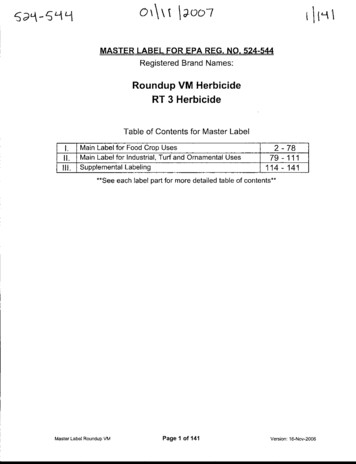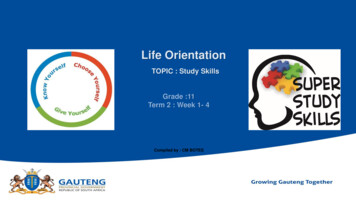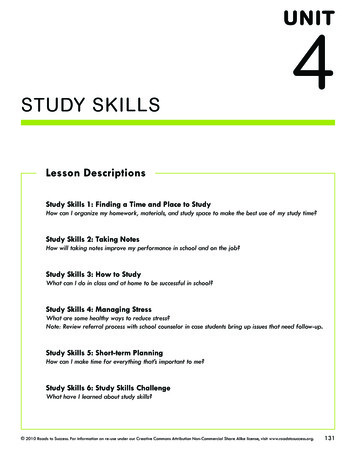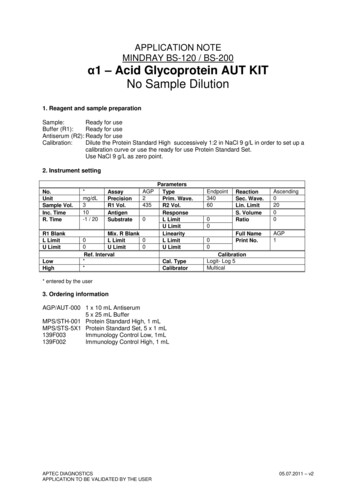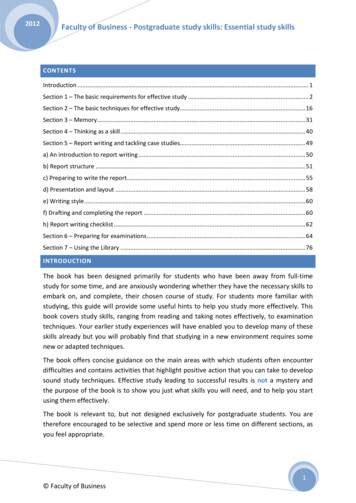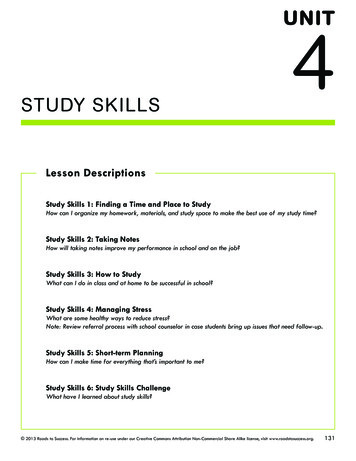
Transcription
UNITSTUDY SKILLS4Lesson DescriptionsStudy Skills 1: Finding a Time and Place to StudyHow can I organize my homework, materials, and study space to make the best use of my study time?Study Skills 2: Taking NotesHow will taking notes improve my performance in school and on the job?Study Skills 3: How to StudyWhat can I do in class and at home to be successful in school?Study Skills 4: Managing StressWhat are some healthy ways to reduce stress?Note: Review referral process with school counselor in case students bring up issues that need follow-up.Study Skills 5: Short-term PlanningHow can I make time for everything that’s important to me?Study Skills 6: Study Skills ChallengeWhat have I learned about study skills? 2013 Roads to Success. For information on re-use under our Creative Commons Attribution Non-Commercial Share Alike license, visit www.roadstosuccess.org.131
PLANNING PYRAMIDGRADE 7, Unit 4, Study SkillsSome Students Will: Identify a viable option for computer andInternet access if not available at home. Create a schedule for one day byestimating how long each task on their listwill take. Schedule time-sensitive to-do items first (forexample, basketball practice at 3 p.m.).Most Students Will: Consistently write down their homework assignments. Identify two students they can call re: missing assignments orhomework confusion. Take notes using the outline, mapping, or Cornell method (includingdifferentiation between main idea and supporting details.) Identify one strategy to review class notes for a test. Prioritize tasks on a daily to-do list.All Students Will: 132Understand the value of a regular time and place to study.Recognize the usefulness of taking notes at school and in the workplace.Identify some of the elements that make the transition to middle school stressful.Understand that different individuals respond to stress differently.Identify two healthy ways to alleviate stress.Create a to-do list for a single day. 2013 Roads to Success. For information on re-use under our Creative Commons Attribution Non-Commercial Share Alike license, visit www.roadstosuccess.org.
Grade 7Study SkillsFamily NewsletterGetting OrganizedRoads to Successis a new programdesigned to helpmiddle and highschool studentsprepare for theirfutures. This newsletter will keepyou posted onwhat we’re doingin school, and howfamilies can followthrough at home.Did you know?Many middleschoolers needhelp getting (andstaying) organized.Start things offone day at a time.Encourage yourchild to keep a listof a few things hewants to get doneeach day. Crosseach task off thelist once it’sfinished.For many students, the firstday of school feels a lot likeNew Year’s Day. They maybe eager for a fresh startand full of resolutionsabout making this yearbetter than the one before.How can families help kidsmake good on theirpromises to do well? Likeadults, kids need to makeconcrete plans to stick totheir resolutions. Here aresome ways to tell if yourteen is on the right track:Does he write down hisassignments for everyclass, every day? The firststep to becoming a goodstudent is to know what’sexpected. Many schooldistricts provide dailyplanners to help studentskeep track of theirassignments. (No fumblingaround for missing scrapsof paper in the bottom ofthe book bag.)Once your student hasdemonstrated he can dothis consistently for two orthree weeks, he’s on hisway.Does she have a routinetime and place forstudying? Say no tonagging by making a studyplan with your child whenthings are calm. Agree onwhen, where, and howshe’ll study. Figure outwhat works for her, andstick to the same routineevery day.Is he able to break downa big assignment into aseries of smaller steps?As kids get older, teachersexpect them to tackle bigassignments given weeksin advance. Avoid thelast-minute rush by helpingyour teen break bigassignments into smallerones. Write due dates forthese smaller assignmentson a calendar, and check into see if your student ismeeting his own deadlines.Does she have the toolsshe needs to get the workdone? Make sure thematerials she needs arenearby: a dictionary, paper,something to write with,the assignment, books,and handouts. A routine ishelpful here, too. Yourstudent should have aplace at home for materialsthat are going to schoolthe next day, and a placeat school for materialscoming home. (This is evenmore important if yourteen spends afterschooltime in more than oneplace.)Grade by Grade: Study SkillsThe transition to middleschool can be a challenge.Students face new kids,new classes, new teachers— each with their ownexpectations.Roads to Success offers aseries of lessons to helpseventh-graders getorganized — from takingnotes to taking tests.We’ll show students howthey can improve theirschool performance. We’llalso show how skillsdeveloped in school carryover into the workplace.(How do doctors,waitresses, and partyplanners use notetakingon the job? )For more about Roads toSuccess, contact yourchild’s teacher, or checkus out atwww.roadstosuccess.org. 2012 Roads to Success; All Rights Reserved. 2013 Roads to Success. For information on re-use under our Creative Commons Attribution Non-Commercial Share Alike license, visit www.roadstosuccess.org.133
134 2013 Roads to Success. For information on re-use under our Creative Commons Attribution Non-Commercial Share Alike license, visit www.roadstosuccess.org.
STUDY SKILLSFinding a Time and Place to Study1The BIG Idea How can I organize my homework, materials, and study space tomake the best use of my study time?AGENDAApprox. 45 minutesI. Warm Up: Are You aSuper Studier? (5 minutes)II. First Things First: Do You HaveWhat You Need? (10 minutes)III. Finding the Time, Setting a Goal(10 minutes)IV. Finding a Special Study Spot(15 minutes)MATERIALS STUDENT HANDBOOK Student Handbook page 23, Are You aSuper Studier? Student Handbook page 24, HomeworkAssignments Student Handbook page 25, My Time,My Place Student Handbook page 26, Study SkillsChecklist Chart paperV. Wrap Up: Study Skills Checklist(5 minutes)OBJECTIVESDuring this lesson, the student(s) will: Create a place to write down their daily homework assignments. Consider the best time and place to study for themselves, understanding the importance ofkeeping this time and place consistent. Identify at least two students they can call for help if they have questions about theirhomework assignments. 2013 Roads to Success. For information on re-use under our Creative Commons Attribution Non-Commercial Share Alike license, visit www.roadstosuccess.org.135
Grade 7, Study Skills 1: Finding a Time and Place to StudyOVERVIEW.In this lesson, students will talk about how to make the best use of their time when they study,from how to keep track of homework assignments to finding the best time and place to study.They’ll begin with a quick quiz that asks about important study habits. Then they’ll discuss theimportance of homework preparation, and how to keep track of each day’s assignments andmaterials to go home. Next, they’ll talk about finding the best time to study, and how to makethe best use of their time. Then they’ll explore finding the best place to study — including whena computer is required — and draw a picture of their own special “study spot.” Finally, they’llassess their own study habits with a study skills checklist.PREPARATION. Make multiple copies of Student Handbook page 24, Homework Assignments. The following handouts need to be made into overhead transparencies or copied onto chartpaper: Student Handbook page 24, Homework Assignments Student Handbook page 26, Study Skills Checklist If feasible, copy the Study Skills Checklist on the back of the Family Newsletter. This willallow students to review this checklist with their families. Write the day's BIG IDEA and agenda on the board.BACKGROUND INFORMATION.Middle school is a big transition for many students. In elementary school, they had one or twoteachers who were there to hold their hands and remind them of assignments and responsibilities.In middle school, they suddenly have five or more teachers — each with their own expectationsand demands. Classes are held in different places, so their “home base” becomes a locker thatthey (and they alone) are responsible for. They also have more materials stored in that locker,with textbooks, notebooks, and other materials for each class. Notes and reminders may reachparents less frequently, so it’s up to students to keep track of their own schedules, papers, and136 2013 Roads to Success. For information on re-use under our Creative Commons Attribution Non-Commercial Share Alike license, visit www.roadstosuccess.org.
Grade 7, Study Skills 1: Finding a Time and Place to Studytest dates. And most importantly, students in middle school are facing much higher expectations.To stay on top of everything, students need to be very organized — but this doesn't come naturallyfor many seventh-graders. They need assistance to organize their assignments, their notebooks,their lockers, and, most of all, their time. Otherwise, students may suffer academically — notbecause of a lack of talent, but because they simply haven’t learned to organize their time tostudy effectively.IMPLEMENTATION OPTIONS.DO NOW:If you prefer, you may choose to use Student Handbook page 23, Are You a Super Studier?as a DO NOW. Give the students three minutes to answer the questions. Once the students havecompleted their quiz, go over the answers and then begin with the discussion in the Warm Up.For Activity II, First Things First: Do You Have What You Need?, if your students' schoolplanners look very different from Student Handbook page 24, Homework Assignments, youmay prefer to create a model page, on either chart paper or the overhead, that matches yourstudents' school planner.You may choose to have the students complete the Student Handbook page 25, My Time, MyPlace after you have discussed both topics, as described in Activity III and Activity IV.As a final homework assignment, state that you'll be checking their assignment notebooks thefollowing week, specifically looking at the students’ list of assignments for the previous day. Youcould also announce that you'll spot check assignment books over the coming weeks, providingraffle tickets or small prizes to students who can find the previous day’s assignments in oneminute or less. Also, you could announce that you will spot check for students’ study-buddynumbers in the same way. 2013 Roads to Success. For information on re-use under our Creative Commons Attribution Non-Commercial Share Alike license, visit www.roadstosuccess.org.137
Grade 7, Study Skills 1: Finding a Time and Place to StudyACTIVITY STEPS.I. Warm Up: Are You a Super Studier? (5 minutes)1. SAY SOMETHING LIKE: Welcome, everybody! For the next few weeks, we’re going tofocus on study skills. Figuring out how to get organized, take good notes, and use yourtime well are keys to success in seventh grade.How many of you think you make the best use of your time when you study? Well,you’re going to take a little quiz to find out! Please turn to Student Handbook page23, Are You a Super Studier? Take a minute to complete the quiz.[Give students a few minutes to complete the quiz. Then ask students to identify theright answer for each question. As the answers should be fairly obvious, this is reallymeant to reinforce some major ideas in the lesson. If time permits, quickly go throughthe quiz, asking students to raise their hands to show which letter best fits their currentbehavior.]2. SAY SOMETHING LIKE: So, how did you do? If you got five or more answers right, thenyou ARE a super studier. If you didn’t, then you could be a super studier — you just needto learn a few basic tips about studying. Today, we’re going to discuss an importantaspect of study skills — finding a consistent time and place to study that works for you.II. First Things First: Do You Have What You Need? (10 minutes)1. SAY SOMETHING LIKE: Who’s ever gone home and realized you don’t have the bookyou need to do your homework? (Show of hands) Or maybe you have the right books,but you don’t know what your assignment is. As you’ve seen first-hand, you can’t studywell unless you know exactly what you need to do, and have what you need to do it.[Ask for volunteers to explain how they keep track of their assignments for each class.You may want to write their ideas on chart paper, an overhead projector, or theboard. Use this brainstorming to explain the importance of writing their assignmentsdown in one place.]You are exactly right! The best way to keep track of your assignments is to haveone place where you write down your homework in every class every day. A smallnotebook is ideal, especially if it’s small enough to tuck into a pocket in your bookbag.138 2013 Roads to Success. For information on re-use under our Creative Commons Attribution Non-Commercial Share Alike license, visit www.roadstosuccess.org.
Grade 7, Study Skills 1: Finding a Time and Place to Study2. SAY SOMETHING LIKE: It’s also important to know what you need to take home eachnight for every class. To help you remember, you could write a simple note or symbolinto your planner — something that’s easy to read at the end of the day when you’repacking up your book bag. For example, you could simply write a “TB” or “NB” next tothe assignment if you need to take home the textbook or notebook in that subject.3. [Allow students to share any notes or symbols they use to remember their assignmentsand/or supplies. To show students one way to organize these assignments, havethem turn to the Student Handbook page 24, Homework Assignments. Call on twovolunteers to share one homework assignment they have that week. On the overhead,model how to record the assignment and needed supplies using shorthand. (SeeImplementation Options for suggestions.)]4. [Emphasize the importance of reviewing this list at the end of the day to make sureyou have all the books and materials you need to take home.]5. SAY SOMETHING LIKE: No matter how organized you are, chances are you’ll leavea book at school, forget to write down an assignment, or maybe realize you don’tunderstand an assignment once you sit down to study. This is when it helps to have atleast one “study buddy,” or someone you can call for help, in each class.I’d like you to open your assignment book, or the notebook you use for most of yourclasses. On the inside front cover, write down two people in your classes that you couldcall if you have a question about an assignment. If you know each person’s phonenumber now, go ahead and write it down, too. If not, do this after class. You could alsokeep these numbers in another handy place that works for you: programmed into yourcell phone or written in a card in your wallet or book bag.III. Finding the Time, Setting a Goal (10 minutes)1. SAY SOMETHING LIKE: What time do you sit down to do your homework? [Take a fewanswers. Ask the students why they choose that time.] This time may vary with eachof you. It really depends on your schedule, other commitments, and even what timeof day you feel most alert. Maybe it’s easier to study right when you get home. Ormaybe you need a break after school, so you study after dinner. Whenever you study,it’s important to get into the habit of studying at about the same time every day.2. SAY SOMETHING LIKE: It’s also important to have enough time to study — and to usethis time wisely. One way to do this is to have a clear goal when you sit down to study. 2013 Roads to Success. For information on re-use under our Creative Commons Attribution Non-Commercial Share Alike license, visit www.roadstosuccess.org.139
Grade 7, Study Skills 1: Finding a Time and Place to StudyThis goal should clearly state what you need to accomplish in each subject. You shouldalso prioritize the assignments — tackling the most urgent and difficult assignments first.To make sure you’re leaving yourself enough time to study, try to estimate the timeeach subject will take.3. SAY SOMETHING LIKE: Of course, we all need to take breaks while we study. Youneed a change of pace when you start to feel fidgety, bored, tired, or your mindwanders. Just remember to keep breaks limited — and short. What are some othergood things to do if you want to take a quick break? [Students respond; stand up andstretch, pet the dog, go to the bathroom, listen to one favorite song, walk outside andtake a deep breath.] If you find your breaks are stretching out, try setting a timer tolimit breaks to five minutes or less.4. [Have students turn to their Student Handbook page 25, My Time, My Place. Havethem complete the first part of the page, “My Time,” in which they’ll consider the besttime of day for them to study and explain why. (See Implementation Options forsuggestions.)]IV. Finding a Special Study Spot (15 minutes)1. SAY SOMETHING LIKE: Just as it’s important to try to study at the same time every day,it’s also important to try to study at the same place every day.[Have students share their favorite places to study — places where they really feel likethey can focus on their homework without distractions; this can be inside or outside theirhome. (If students do not seem to have a quiet place to work, have them describe theirideal study setting.) List these places on the board.]2. [Point out how different these places are. What works for one person may not foranother. It’s up to them to find the place that works best for them. Briefly discuss someimportant things to consider when finding a good place to study:NOTE: Write the four factors (bolded words) below on the board, overhead, or chartpaper to assist in your class discussion. Comfort: This could be a desk, kitchen table, bed, comfortable chair, or even thefloor. Just be sure you’re comfortable and have room to spread out your books. Sound: Turn off any noises that are distractions — the television, a loud radio, oran iPod. Interruptions: Find a place where you won’t be interrupted or distracted by140 2013 Roads to Success. For information on re-use under our Creative Commons Attribution Non-Commercial Share Alike license, visit www.roadstosuccess.org.
Grade 7, Study Skills 1: Finding a Time and Place to Study anyone. Put a sign on the door and turn off your cell phone and instant messagingon your computer.Materials: Be sure you have everything you need where you study — paper, pens,pencils, calculator, dictionary, and access to any books, phone numbers, or websitesyou'll need.]3. SAY SOMETHING LIKE: What if you need a computer for your assignment? Of course,lots of students don’t have computers at home.[Have students name places where they can use the computers (besides their own homes)and make a list on chart paper. Next to each, talk about what you might need to do touse that computer. For example, you would need to sign up to use the computer lab atschool, making sure there’s not a class using the lab. If you use a computer at the library,find out when the busiest times are so you don’t get there to find out all the computersare in use. Help students see that they do have different options.]4. [Have students turn to their Student Handbook page 25, My Time, My Place. Havethem think about a place they know of that would be a good place to study and writethat place under “My Place.” Then have them draw a picture of this special “studyspot.” Have them write a caption or include labels to point out what makes this a goodplace to study. Maybe there’s room to spread out, pens and paper, a comfortablechair, their favorite hat, or a radio to play soft music.]5. SAY SOMETHING LIKE: If you are going to try a new place to study or use thecomputer, it might take some getting used to. When you begin anything new, it can feelweird at first. If you’re studying at the library for the first time, you might walk in andimmediately feel like you want to leave. But give it a few times — I promise it will feela little less strange each time you do it. By the end of the week, you may have foundthe perfect study spot.V. Wrap Up: Study Skills Checklist (5 minutes)1. [Have students take a minute to share their Student Handbook page 25, My Time, MyPlace with a partner.]2. SAY SOMETHING LIKE: Before we end for the day, I’d like you to reflect on your ownstudy skills.[Have students turn to Student Handbook page 26, Study Skills Checklist, and checkeach one they feel they do.] 2013 Roads to Success. For information on re-use under our Creative Commons Attribution Non-Commercial Share Alike license, visit www.roadstosuccess.org.141
Grade 7, Study Skills 1: Finding a Time and Place to Study3. SAY SOMETHING LIKE: Take a look at your list and think about which study skillsmight still need some work. The first thing I'd like you to focus on is keeping trackof homework assignments. Your assignment for next week is to bring in your list ofassignments from the previous school day. Remember, your list should clearly show theassignment in each subject, and the materials needed for each one.4. SAY SOMETHING LIKE: You all have done a great job today. Remember, if it takessome time to find a perfect time and place to study, don’t get discouraged. It mighttake some time to find what works best for you. You have lots of people who want tohelp you — parents, teachers, counselors, librarians. All you need to do is ask!142 2013 Roads to Success. For information on re-use under our Creative Commons Attribution Non-Commercial Share Alike license, visit www.roadstosuccess.org.
Grade 7, Study Skills 1: Finding a Time and Place to StudyStudent Handbook, Are You a Super Studier?Are You a Super Studier?Below are some familiar situations. Circle the best answer for each one.1. It’s time for school! Before you rush out to meet the bus, you:A. Run around the house looking for your book bag, stuffing in whatever notebooksand textbooks are lying around.B. Grab your book bag from your room, but wonder if all your notebooks andtextbooks are in it as you head out the door.C. Grab the book bag from its regular spot. You know everything you need is there,because you packed it the night before.2. The bell has rung and you’re walking out of class with a friend. Your teacher says,“Tonight, please read chapter 3 and answer the questions at the end.” You:A. Keep walking out of class, telling yourself you’ll remember the assignment.B. Write it on a scrap piece of paper and shove it into your book bag.C. Take out your homework notebook and write it in the day’s list of assignments.3. You get home and realize you didn’t write down your math homework. You:A. Call someone you know in that class to find out the assignment.B. Plan on doing your math homework during your science class.C. Celebrate! No math homework tonight!4. Your social studies teacher wants your paper typed on a computer. You don’t have oneat home, so you:A. Ignore her request and write it in your neatest handwriting.B. Figure you’ll use the computer lab the day it’s due.C. Sign up to use the library computer at least twice that week, in case it takes longerthan you expected.5. It’s time to head home, so you swing by your locker. You:A. Pick up your book bag and whatever books you think you might need forhomework that night.B. Check your homework notebook to see what books and other materials you’ll needfor homework that night.C. Look at all the books in your locker, feel overwhelmed, and go home with anempty book bag.6. You know you have a paper, math homework, and lots of reading to do beforetomorrow. Before you get started, you:A. Eat a snack, call a friend, check your e-mail, call another friend, check your e-mailagain.B. Grab your books and turn on the television.C. Go to your special, quiet spot for studying and set a goal for what you need toaccomplish. 2013 Roads to Success. For information on re-use under our Creative Commons Attribution Non-Commercial Share Alike license, visit www.roadstosuccess.org.23
Grade 7, Study Skills 1: Finding a Time and Place to StudyStudent Handbook, Homework AssignmentsHomework AssignmentsNameFromto(beginning of the week) (end of the week)MondayTuesdayWednesdayThursdayFriday1st PeriodSubject:2nd PeriodSubject:3rd PeriodSubject:4th PeriodSubject:5th PeriodSubject:6th PeriodSubject:7th PeriodSubject:8th PeriodSubject:9th PeriodSubject:You are responsible for writing down your assignments for class. If there’s nohomework, write “NH” (for “no homework”) so you know you didn’t forget to writesomething down.If your school has fewer than nine periods a day, cross off the extra spaces at thebottom. If your school is on a six-day cycle, fill in your homework assignments forone week only. 2013 Roads to Success. For information on re-use under our Creative Commons Attribution Non-Commercial Share Alike license, visit www.roadstosuccess.org.24
Grade 7, Study Skills 1: Finding a Time and Place to StudyStudent Handbook, My Time, My PlaceMy Time, My PlaceMy TimeThe best time of day for me to study isbecauseMy PlaceThe best place for me to study isDraw a picture of this special study spot below. Include a caption or labels to pointout why it’s the best place for you to study. 2013 Roads to Success. For information on re-use under our Creative Commons Attribution Non-Commercial Share Alike license, visit www.roadstosuccess.org.25
Grade 7, Study Skills 1: Finding a Time and Place to StudyStudent Handbook, Study Skills ChecklistStudy Skills ChecklistHow are your study habits? Read the list below, and check each item thatapplies to you most of the time.I have one place to write down my homework assignments and any booksthat need to go home every day.I check this list every day when I’m packing my book bag to go home.I have a special place to study that’s comfortable and quiet.I have all my study materials in one place — including paper, pencil,calculator, and dictionary.I have a place to use a computer if I need it.I study at about the same time every day, and know that this is the besttime for me.When I sit down to study, I have a clear goal of what I want to accomplishin each subject.I usually have enough time to finish my homework.I have the phone number of at least one person in each class who I couldcall with a question about an assignment.Every night, I put all the things I need to take to school the next day in thesame place. 2013 Roads to Success. For information on re-use under our Creative Commons Attribution Non-Commercial Share Alike license, visit www.roadstosuccess.org.26
STUDY SKILLSTaking Notes2The BIG Idea How will taking notes improve my performance in school and onthe job?AGENDAApprox. 45 minutesI. Warm Up: Scavenger Hunt(5 minutes)MATERIALS STUDENT HANDBOOK Student Handbook page 27, What’sMy Line?II. What’s My Line? (10 minutes) Student Handbook page 28, Note-takingMethodsIII. Take Note! (15 minutes) Student Handbook page 29, Note-takingMethods (The Red Effect)IV. The Red Effect (10 minutes)V. Wrap Up: Study SkillsAssignment (5 minutes) FACILITATOR RESOURCE Facilitator Resource 1, DO NOW: TakingNotes Facilitator Resource 2, The Red Effect Blackboard or overhead projector Index cards (optional)OBJECTIVESDuring this lesson, the student(s) will: Understand the importance of taking notes in school and at work. Compare and practice several methods of taking notes on material presented verbally. 2013 Roads to Success. For information on re-use under our Creative Commons Attribution Non-Commercial Share Alike license, visit www.roadstosuccess.org.147
Grade 7, Study Skills 2: Taking NotesOVERVIEW.In this lesson, students play a game in which note taking is important. They also guess people’sprofessions by looking at their notes. After modeling different ways of taking notes, studentspractice the different methods in a group activity.PREPARATION. The following handouts can be made into overhead transparencies or copied onto chartpaper: Student Handbook page 28, Note-taking Methods Student Handbook page 29, Note-taking Methods (The Red Effect) Facilitator Resource 1, DO NOW: Taking Notes Facilitator Resource 2, The Red Effect The paragraph, "This Monkey's Business was Art," from Activity III. Familiarize yourself with the different forms of note-taking methods you will modelduring Activity III, Take Note!. For additional information about note-taking systems, g.systems.html. Write the day's BIG IDEA and agenda on the board.BACKGROUND INFORMATION. . .Taking notes helps students focus attention during class and remember the ideas and factspresented once class is over. It also encourages students to make connections and elaborate onclassroom discussion topics. It helps them process information more fully, and to recall informationwith greater ease. It is important for students to find the note-taking method that works best forthem. For this lesson, there is a considerable amount of time reserved to explain how to takenotes in a step-by-step format so students will be able to understand and adopt the methodthat works best for them.NOTE: This lesson is intended to prepare students for note taking based on a lecture, rather thanwritten text.148 2013 Roads to Success. For information on re-use under our Creative Commons Attribution Non-Commercial
Study Skills 3: How to Study What can I do in class and at home to be successful in school? Study Skills 4: Managing Stress What are some healthy ways to reduce stress? Note: Review referral process with school counselor in case students bring up issues that need follow-up. Study Skills 5: Short-term Planning
